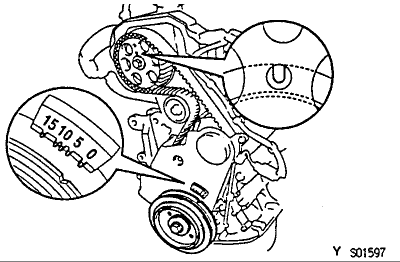When changing the timing belt/chain or adjusting timing on a vehicle, understanding the timing marks on the crankshaft and camshaft pulleys is key to getting it right. Tuners will also need to be intimately aware of these marks as they are integral to tuning RPM rates.
Timing Marks
Most engines will have two or three marks on the inner crankshaft pulley to be lined up with the “arrow” mark on the engine block. Similar marks will usually be found on at least one of the camshaft pulleys. When the timing belt or chain is properly installed, the mark set to the block mark on the crankshaft will be identical to the mark set to the camshaft and head. The goal of setting timing is to have this lineup happen.
The top dead center (TDC) mark can be the center, left, or right mark, depending on the engine. On the majority of engines, it is the center of three marks, but your specific vehicle may differ, so reference your owner’s manual and/or shop repair manuals.
Which brings us to user Jesusgil’s question:
What Are The Other Marks For?
These are the Below and Above (also called Before and After) TDC marks. We reference them as “left” and “right” of the center mark seen as you face the front of the engine (where the belt is located), not in the traditional sense of “left” being driver’s side because these marks are specific to the engine, not the vehicle.
The Below Top Dead Center (BTDC) mark is the one to the left and the ATDC mark is the one to the right. These are measurements of degree and are slightly different depending on the engine in question.
On a typical four-cylinder, for example, the first mark is 7.5-degrees before top dead center, the center marks is TDC, and the mark to the right is 5 degrees after top dead center. Again, these numbers of degree can change according to the engine in question.
When you move your timing to coincide with one of the other marks, you’re changing the valve timing of the vehicle. If done in concert with the engine block (crankshaft marks), this can produce lower or higher RPM at the top or low end in order to produce more power at different engine speeds. Moving these changes how much power the engine has at the lower end (slow speeds) or higher end (higher speeds) for racing or efficiency.
Why Change the Alignment to ATDC or BTDC?
When the timing is moved so that it is before or after top dead center, it changes how “open” or “closed” the cylinder is before fuel and air mixtures are injected and the spark ignites them. This, in turn, changes how much of the combustion chamber is available to the burn when it’s ignited, which changes how much of the piston’s travel is pushed by the burn rather than engine momentum. The more of that travel that is pushed by the burn, the more efficient the engine will be, but that burn:travel ratio changes at various RPM.
By tuning to low- or top-end optimization, the mechanic is opting to sacrifice efficiency at one end in favor of the other. By tuning directly at TDC instead, though, the mechanic is tuning for averaged efficiency at all levels – which is why engines come from the factory with TDC as their timing point.
In older engines, changing the timing to BTDC or ATDC will mean replacing the distributor with one built for that new timing. Soem adapter kits are available for some engines in which these changes are popular, however, that allow elements of the distributor to be replaced rather than the entire unit. On more modern cars that use electronic timing, the change to ATDC or BTDC usually require only a “computer reprogram” to change the spark/ignition timing.







